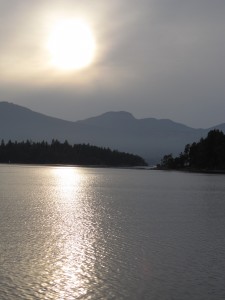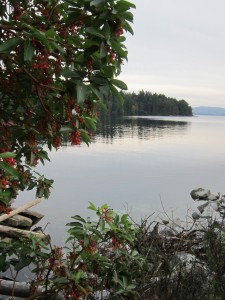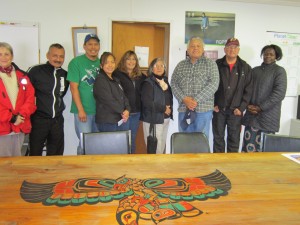A welcome to Penelakut Island part 1

(A perspective on settler and Indigenous relationships in the Gulf Islands, including Penelakut, is offered by award-winning author Terry Glavin in the article This Haunted Place. Terry has for many years written about the Indigenous history and ongoing resistance that lie below the official stories in BC.)
On a cold, grey morning Penelakut (Puneluxutth) First Nation member Jill Harris, Gloria Cope of the local United Church, Chantal, Rachel and I took the 20 minute ferry ride from the largely white community of Chemainus to Penelakut Island; all but 100 acres of it are a recognised reserve for the Penelakut people. About 350 people live full time on the island, along with the administration offices for the band, an elementary school, daycare, and health clinic, all run by the First Nation.
The Penelakut people are part of the larger Hul’qumi’num group, who in turn are part of the Coast Salish people whose traditional territory runs up the east coast of Vancouver Island, across the Gulf Islands, up the huge delta of the Fraser River and into its lower reaches. The territory is as much about the water as the land, because the Hul’qumi’num remain deeply rooted in the incredibly rich fresh and salt waters of their territory. But access to land and water alike have been drastically reduced over the preceding 200 years, to the point that about 85% of the lands under the current, extremely slow and costly treaty process are under private ownership by non-Aboriginal newcomers.
The chief and the council graciously interrupted their day-long meeting and asked us to speak–an act of hospitality that has been true of every Indigenous community and individual we’ve met.
We had heard earlier about the shooting death of a young woman at the hands of her boyfriend, and were told by a female councillor (whose name we won’t share here) that the victim was her sister. She was open about the violence in Penelakut– an openness that sometimes could not be shared by others and forced us to face the very difficult problems of those who do speak out in the context of small communities where patterns of violence and abuse are deeply rooted in colonization and dispossession.
Elder Augustine Sylvester spoke to the traditional belief that violence against women was utterly unacceptable and cause for the perpetrator’s banishment on pain of death. He said a return to old ways of being was needed, which in turn called for an active struggle against the values imposed by colonization. He pointed over his shoulder at the hill that had housed the Kuper Island residential school, run by the Roman Catholic church: “Far too many of our problems today began with that school and all that was done there. We are still recovering from it.”
Gloria spoke briefly about her 20 years of work with Jill on dialogue and right relationship, and stressed that as a non-Aboriginal woman she did not wish to come bearing solutions; that it was time for white people to stop talking, set aside our stereotypes, and listen carefully and long-term to Aboriginal people. Part of that listening is to recognise the wrongs that newcomers and settlers have committed, and to be willing to own up to our part in oppression.
We then went up the hill to the health centre, where we discovered that because of a miscommunication, a group of young parents and clinic staff had been patiently waiting for over an hour. After apologies, we got down to it; Chantal began with an explanation of her work and her country’s context, taking time to paint a grim picture of the violence visited on villages not dissimilar to the one we were sitting in: of the attacks in the middle of the night by Rwandan rebels hiding in the surrounding forest; of the rapes, murders and total dispossession that resulted; of the further oppression of women in the form of poverty, of crops stolen once harvest time comes; of checkpoints in the market where she must bribe her way past Congolese army and police; of the fact that virtually all perpetrators walk around freely. A young man asked if this was all still going on today. Yes, said Chantal.
Jill explained her connection to the Women of Courage work through her visit to Colombia and through the ongoing commitment to link the global experiences of Indigenous women. Then we moved to a more open discussion about Penelakut Island, with Chantal asking about the local situation. We were in an open circle, and there were some differing points of view about the level of violence against women and young people in the community, especially around sexual violence. Older women affirmed that in the past, violence had been a serious problem. Some were not sure that it remained a problem.
Others spoke of a woman who pressed charges against her abuser, taking the risk of speaking out in a small community. Sure enough, charges against him were eventually dropped and he remains in the community. Impunity is not only a Congolese reality.
Only after did one woman talk more privately about years of beatings at the hands of her husband and her concerns about the impact on her children. When the children were grown, she felt that she could finally leave; if he killed her, at least the children could now survive.
Again and again people made reference to the residential school and its looming presence in so much of the legacy of violence and spiritual dispossession with which the community continues to struggle. Throughout the day, the presence of the school seemed to sit at the edge of our seeing and hearing. The community tore down all but one building, performed a purification ceremony and then built again, on their own terms. Jill stood and told a small part of her very difficult time at the school, making herself an example of breaking the silence that so often surrounds violence and abuse.
Despite the difficult discussion, the hospitality was warm. The chance to have this discussion with a dozen people from the community was extremely important and we were deeply grateful for all who took a risk with outsiders present and joined in it. (Continued in the next post.)



